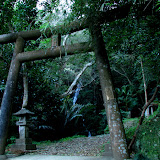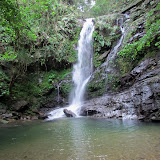 |
| A very small waterfall at the Takazato River |
GPS
| Latitude | Longitude |
| N 26 42.259 | E 128 10.185 |
River Trekking the Takazato River
The Takazato River that borders Ogimi and Kunigami Village can be fun and enjoyable, and yet very challenging for even the most experienced nature hiker. If you thought river trekking to Fukugawa II was somewhat strenuous then Takazato will give you a real good workout. There are a lot more risks here however, and more caution is required. This can be rewarding and fun, but you have to respect nature and your limits. If you have poor agility and coordination, then you will have a tough time. Along the way, you will have to negotiate small boulders. And at times, in the interest of safety you may have to skirt the river via small trails off to the side that are often masked by thick vegetation. The risk here then becomes snakes. It is highly recommended that you read all the guidelines below. This can be adventurous and exciting, but respect towards mother nature must have the highest priority.
Interesting things to see. Click on the photo album above to see the some of the natural beauties along the way. When you arrive at the parking area, you will see a
small dam. It's an interesting setup and a good place to just relax if nothing else. Once you begin your journey, you will see a noticeably unique '
Gajimaru Tree'. Further down the river, you will see the '
Fern Arch', consisting of what appears to be two dying trees with an abundance of ferns that have taken over. You will also see many, many
boulders with beautiful cascading water streams. The highlight of this journey is a
small waterfall (1.5-2 meters high) that you see above that pours into a good size pool of water.
Starting Point. The start of the trail begins at the parking area
behind the picnic tables. You will see a noticeable trail that takes you little higher up a hill. It takes you behind the dam.
Highlight/Turn-around Point. The highlight of this trip is a
small pretty waterfall (1.5 - 2meters high) that goes into a large pool of water (above picture). This is about 1hr 30 minutes to 1hr 45 minutes away from the starting point. Further past this point are more rocks and boulders and the '
turn-around point' is at
GPS N26 41.966 E128 10.328. Both are marked in the map above. You will notice on the map that a farm is about 300 meters due east of the turn-around point. It is not certain what is further upstream beyond the turn-around point.
Trekking Time: 1:30-145 minutes at a reasonable safe pace to the turn-around point.
Directions. The main turn-off is from Highway 58 just before the
statue of the Yanbaru Kuina. From there, getting to the actual starting point may take some doing. Essentially, you are following the Takazato River on the south side. Study the map carefully. You will see another designated landmark of
apartment buildings just before you go onto the dirt road leading you to the starting point.
GUIDELINES (PLEASE READ).
The Guidelines are similar to that of going to Fukugawa II with a few exceptions. Because this trek is little more difficult please read through all the guidelines.
1. VERY IMPORTANT. This particular river trek is recommended only for those who have fairly good physical agility and coordination skills. Negotiating large boulders may be required at times. Recommended only for young adults and above.
2. VERY IMPORTANT. Plan on getting wet up to your knees. It will sometimes be safer just to walk in the river, rather than hopping and balancing yourself on the boulders & rocks just to keep dry. If the boulders are wet (& best to assume they will be), they will be slippery. Though this rule may seem trivial, it is a very important thing to remember. The biggest risk trekking along this stream is slipping and falling on the rocks.
3. DO NOT WEAR TENNIS SHOES!!! Tennis shoes offer no traction and will slip on these rocks. Wear something that has hard soles and has great traction on these kinds of surfaces. If you do not have hard soles you will 'feel' every step you take. And since you will be getting wet, thick heavy boots will only get heavier when soaked. You should wear something that is lighter, has good traction, but still gives you flexibility of movement.
4. GUIDE STICK. It was not recommended for Fukugawa II that you do bring a guide stick, however, it will be needed here. Sometimes it will be safer to skirt the terrain just to avoid large boulders. You will see some trails that may have thick vegetation. You will need a guide stick to probe these areas and to knock down spider webs. When you are negotiating boulders however, you will have to set your guide stick aside to free your hands for climbing.
5. Never go alone. Have a buddy. For this particular river trek, the 'ideal' number is to have at least three (3) hiking buddies if you can, but optimally to have more than 3 due to the level of difficulty. If one gets hurt, then you have the option of leaving one with the injured while the other go gets some help. Cell phone reception is very difficult, if not non-existent in these areas. If you are a US Service Member, your nearest US Military Facility will be the Okuma Recreational Facility. It is recommended that everyone should have the number to this location should an emergency arise.
6. Tell someone where you will be river trekking at and leave them the GPS coordinate of the starting point. The starting point is N26 42.259, E128 10.185.
7. Wear something that is long sleeve and light (depending on the weather) for protection against the elements and bugs. Whether you trek on the river or skirt the landscape, you will hit spider web after spider web (summer or winter).
8. Wear a hat or beanie to keep warm and to protect yourself against the elements and bugs. You will run into many spider webs along the way (Do a 'spider check' with your buddy every now and then). A beanie does offer some bit of protection as a cushion in the event of a fall.
9. Bring some light hiking gloves for grip and protection. You may be required to grab roots, tree limbs, trees, rocks, dirt, etc. in order to negotiate terrain.
10. DO NOT WEAR SHORTS. Find something that you don't mind getting wet in and that offers protection against the elements. There 'will' be a few times you will be on your knees or on your rear end as you negotiate some of the terrain. Also you need to protect your legs from critters. You may want to bring some shorts if you want to take a dip in the water pool later.
11. Apply the '3-Points of Contact Rule' when going over difficult terrain.
12. Maintain a low center of gravity when going over difficult terrain.
13. If something looks unsafe, then don't do it. Find another way to go around it or SIMPLY, DON'T DO IT. Don't try to be brave.
14. Give yourself plenty of time AND TAKE YOUR TIME. NO NEED TO RUSH. But remember you have add time to get back (before dark!). Recommend you leave early morning time frame.
15. Bring a light backpack for food, water, toilet paper, flash light, survival kit, first aid kit, light rain coat, warming layers, etc.
16. USE THE BATHROOM BEFORE YOU GO! Making natural deposits of certain kind in the wild may not be fun for some.
17. You will get dirty. Bring a towel, extra socks, extra pair of shoes, shirt, pants, warming layers (Can leave in the car).
18. Tuck in your shoe laces to prevent tripping.
19.Protect & secure items such as your wallet and cell phone from moisture and from getting soaked.
20.Don't try to be brave. Respect your limits and respect nature.
21. You do not have to go all the way to the Highlight or Turn-around Point. You don't have to go far to enjoy some of the beauty along the Takazato river. Never feel pressured to continue on if you are fatigued or if it becomes too hazardous.
22.
The Water Dam. The water dam area at the starting point has some
deep areas. Parental supervision is required when small kids are in the area.

















